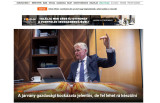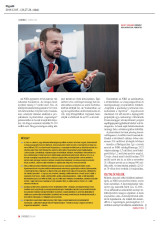"IIB: Relaunch 2.0". Deputy Chairperson of IIB Management Board Imre Laszlóczki reflects on the Bank's Anniversary and strategic development in his interview to Figyelô.

Re-launch 2.0
It's been fifty years since the International Investment Bank (IIB) was founded. What was the purpose of its foundation in 1970? What were its functions?
Exactly 50 years ago, on July 10, 1970, the founding states put their signatures on the historic Agreement on the Establishment of IIB. The agreement was registered with the UN secretariat, and thus, a new international organization appeared in the world – International Investment Bank. IIB is one of the oldest development banks in the world, the institutions founded earlier can be counted on the fingers of the hand - the World Bank (1944), the European Investment Bank (1958), the Inter-American Development Bank (1959), the Asian Development Bank (1966).
The main objective of the Bank was to provide long-term (for several decades) and large (hundreds of millions and billions of euros in equivalent) loans for large-scale cross-border integration infrastructure projects, primarily in theraw materials and energy sectors, as well as financing projects for technical re-equipment and construction of new large-scale industrial facilities in the member states of the Bank.
It is important to note that through its birth and all subsequent activities, our Bank de facto contributed to the consistent dismantling of the Iron Curtain, as it not only successfully strengthened ties between its member states, but also acted as an effective international platform for their economic cooperation with other countries, primarily European.
It was the efforts of IIB that the energy infrastructure of the Eurasian continent based on the Soyuz and Progress gas pipelines was created and by the way - it still remains fully operating. These investment transactions rightfully went down in history as exemplary deals of cross-border economic integration and became a symbol of the beginning of an era of discharge of international tension. Thanks to these pipelines natural gas was first supplied to Germany and Austria. And from Europe for the construction of the pipeline went high-tech equipment, machinery and, most importantly, large-diameter pipes. This IIB integration project marked the beginning of the policy of “warming” and the reduction of international tension, which had begun at that time.
After the regime change, with the end of socialism, the role of IIB decreased significantly, later on it suffered a grave crisis and ceased to function. In 2012, however, it was relaunched, why?
Even at a time when the geopolitical map of the world was undergoing tectonic changes, IIB, although it slowed down the pace of development, but - resisted, did not go down in history. And there were good reasons for that. The member states of the Bank saw in our institution an effective, flexible, well-known and understandable instrument for the effective targeted attraction of investments in important sectors of the economy.
Though Hungary quit IIB for a short time from 2000 – due to serious internal debates within the government - but re-joined the Bank seeing the visibly sustainable results after the reforms carried out by the financial institution since 2012.
Nevertheless, it is necessary to emphasize the special role that Russia and Hungary played in the fate of the Bank during this period. In the 2000s, it was the Russian Federation that provided the Bank with significant financial support, essentially opening the way for its relaunch, and the returnof Hungary as a shareholder in 2015 and its initiative to move the IIB Headquarters to Europe.
All 8 years that have passed since the relaunch in 2012, IIB conducted hard work based on new statutory documents, a balanced corporate governance system created with the support of the World Bank and meeting the best practices of multilateral development institutions, to create a modern development institution that meets the best international standards and practices. Today, our activities we have an exemplary risk management system and consistently implemented development strategy.
As a result of a comprehensive reform of its activities, the Bank has become a recognizable, visible and fully-fledged member of the international community of development institutions with credit ratings of highest level “A”.
At the domestic banking market IIB is still considered to be small; in which niche market would you like to grow? You regularly express your devotion to Europeism - what does this mean exactly?
Indeed, although the Bank has been growing dynamically since 2012, the scale of our business is not as large as that of the “giants” of the international financial community. But it is precisely this “boutique” character that today gives us many serious and tangible market advantages. IIB easily, often proactively, makes contact with clients and partners, we very quickly consider potential projects, quickly make decisions.
The uniqueness of our business model lies in the fact that we undertake projects whose implementation is very important for our member countries, but which, due to their scale, are not interesting to the largest development banks, and due to their low profitability and high time duration, are ignored by commercial banks.
Today, the Bark implements projects in such priority sectors as green energy, food processing, pharmaceuticals, agriculture, infrastructure, and makes up its ownmarket niche, in which IIB, I must say, feels great. Let's not forget about supporting cross-border trade - IIB is very active in working with “trade finance” products, contributing to the implementation of foreign economic transactions between companies of its member countries. The volume of transactions supported by IIB in the field of trade finance today is already more than 400 million Euros, and the number has exceeded two hundred. A significant share of them falls on the export of high-tech products from European countries - participants of the Bank to IIB countries from other key geographies.
Speaking about the “Europeanization” of IIB, I would like to note that this is the most important vector of our long-term strategy and the key to the successful development of IIB for many years. And this is completely natural and logical for the Bank. I will give only a few eloquent facts.
5 out of 9 of our member states are EU members. These states form the overwhelming majority of votes in all key decisions about our activities, have more than 50% (51.28%) in IIB’s paid capital. Four out of 5 Deputy Chairpersons of the Management Board are EU citizens. More than half - 55% of the total IIB loan and documentary portfolio consists of investments in the interests of our European shareholder countries, more than 70 (!) of attracted funding - the main source of funds for lending to customers - the Bank also receives on European capital markets, and the vast majority of the more than 200 institutional investors of IIB are mostly located in Europe.
With the move to Europe, IIB became significantly closer to its main customers, partners and investors, significantly reduced the cost of funding, which was immediately and positively accepted by international rating agencies, which assigned IIB investment ratings of the highest “A” level.
In addition, companies from Europe want to do business in Russia, Mongolia, Vietnam and Cuba, where their products and know-how are really needed. At the same time, the IIB's Europeanization fully meets the interests of the IIB member states from other key geographies interested in establishing and strengthening economic ties with the countries of Europe. For them, the states of Europe are strategic markets, a source of investment and import of modern products and high technologies. Thus, the Europeanization of IIB is a great example of a win-win strategy.
Last June IIB moved its headquarters from Moscow to Budapest. What was the motive, and what is the current mission of the Bank? Why is Hungary important for the Bank?
Having had many years of experience as a career diplomat and ambassador who represented Hungary in various countries of Europe, Asia and the Middle East, I cannot but take this opportunity to praise the policy that the current leadership of the country has consistently pursued in the international arena.
Today, the voice of Hungary sounds confidently and loudly throughout the world, and even the most powerful and influential players listen to it. Our country, being a responsible, active member of the EU and a staunch supporter of its strengthening, nevertheless, invariably and firmly defends its national interests. Hungary's policy is distinguished by its multi-vector approach, practicality, and readiness for a mutually beneficial dialogue with partners around the world.
In my view Hungary made the right decision to return to the IIB shareholders. By 2015 it became clear that the Bank had successfully restarted, was operating without regard to politics, was gaining momentum confidently, was investing 7 times more in member countries than each shareholder contributed to the Bank’s capital, had great experience and knowledge of their geography, many of which are excellent markets for the sale of products of the Hungarian industry, and, moreover, concentrates on supporting priority sectors for Hungary and medium and small projects, which form the basis of the country's economy.
Currently, the share of Hungarian projects amounts to almost 10% of the IIB's loan and documentary portfolio. Only in recent weeks, despite the epidemic of coronavirus, we have approved several new Hungarian transactions in the amount of over 120 million euros, and another 185 million are in a promising pipeline.
IIB is a Bank of 9 countries and 3 continents. All of them have different economic and social profiles. What kind of business model helps you to manage these regions, and how much politics is involved in the course of business?
As our Chairman Nikolay Kosov often says - "our member states always get along better at the Bank than in everyday life”. And it is absolutely true: IIB is 100% out of politics, the Bank is guided only by its high mission of the multilateral development institute.
And, yes, we are successful in cooperation with our shareholders, the active support of which, as all international rating agencies, which assigned the Bank (and, importantly, confirmed at the very height of the epidemic!) Investment ratings of the highest level “A”, emphasize, - is the basis and key factor our development and growth.
Despite all the objectively existing differences in the economy, political structure, understanding of the paths to progress, our countries are united in their plans for the consistent and universal development of IIB and the expansion of its activities. Shareholders see us as an understandable, transparent and invariably effective tool to support their economies and expand international economic cooperation.
For example, the decision to relocate the Bank’s headquarters to Europe and, in general, the course towards the Europeanization of activities were unanimously supported by all the Bank's member states.
The Bank has a three-tier management system, which provides for the work of the Board of Governors, the Board of Directors and the Management Board of the Bank. The Board of Governors (BG) is the highest collegial governing body of the Bank; member countries appoint their authorized representatives, as a rule, these are Ministers of Finance, Heads of the Central Bank, it meets at least once a year and determines the IIB's strategy.
The Board of Directors (BD) meets at least once a quarter and carries out general management of IIB, including approval of key transactions, and supervision of its current activities. The operational management of the Bank is carried out by the international Management Board. Four out of the six-member Management Board are EU citizens.
Thus, the member states at any given time have all the information about the Bank’s activities, the constructive dialogue with them does not stop even for a moment, we perfectly understand the financing needs of our member states, and the shareholders fully understand our capabilities. In aggregate, this guarantees the Bank consistent support to shareholder countries on all issues.
What time period does your strategy cover, what are the development vectors for the years to come?
IIB’s development strategy is set for five-year terms. The period of 2013-17 is called Relaunch strategy, while the current strategy which covers the period from 2018 to 2022, adopted in Bucharest in 2017 is labelled with the name Development strategy. Today IIB lives according to the so-called “Development Strategy”, however, the Bank has the clear vision of its development directions until at least 2032, outlined in a normative document prepared in 2019.
The strategy for the period between 2023-27 will be worked out from the middle of next year, taking into account the relocation of our Headquarters. As working title we use for the time being "Re-launch 2.0", but based on its likely content the name "Strategy of Europeanisation" seems to be also possible.
The Bank will continue its course towards a comprehensive Europeanization. The share of European member states in all key indicators - the paid-in capital, loan portfolio, funding - will consistently and steadily increase. We also plan a gradual expansion of the Bank’s shareholders list through the adoption of another 1–2 countries in the 3-5 year term. In this area, we are actively consulting both with European countries and with potential participants from other key geographies - primarily from Asia.


